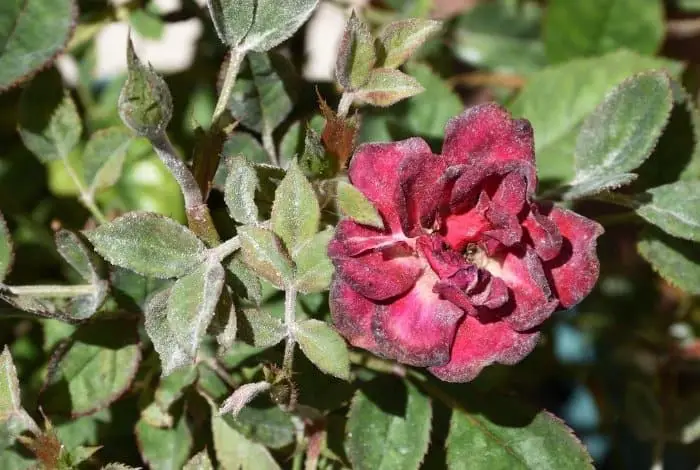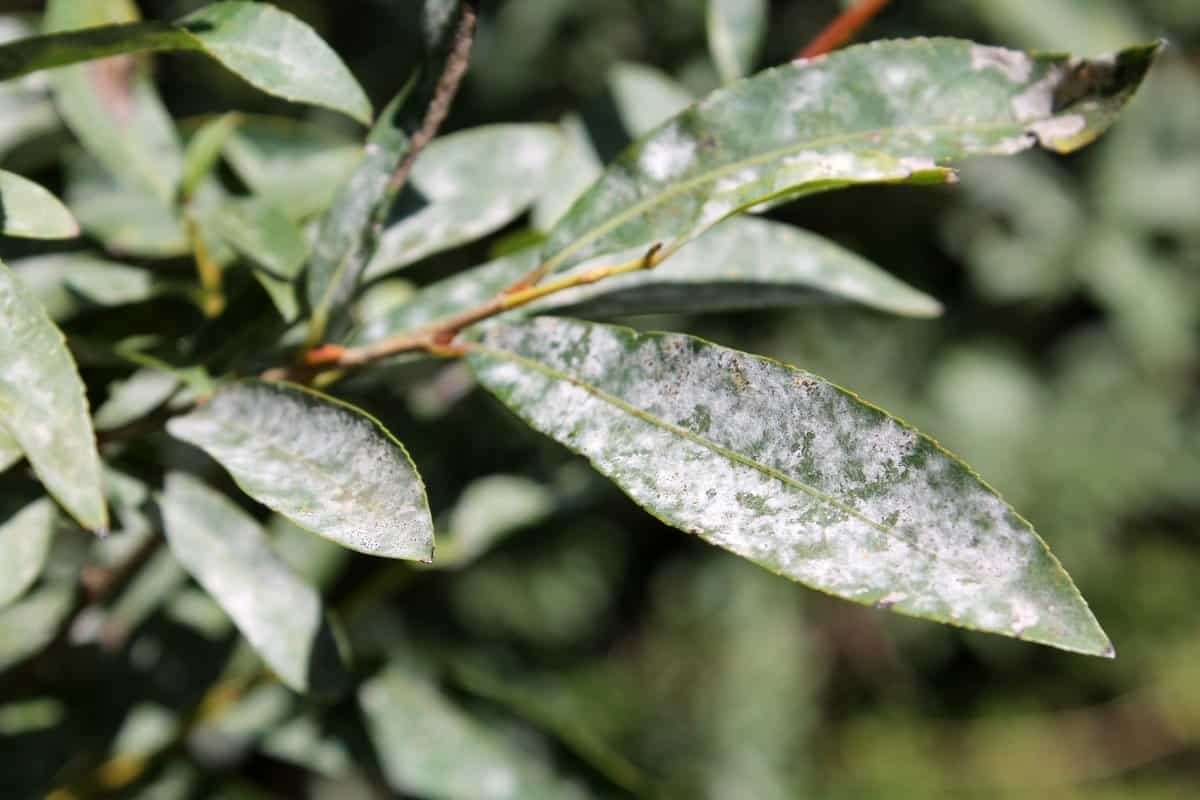Last Updated on February 17, 2022 by
White powdery patches or spots on the top side of the leaves or on the plant’s stems are early signs of white powdery mildew arrival.
Powdery mildew is a fungal disease that causes destruction on a plant’s stems, leaves, and flowers causing lots of destruction. It is the most common fungal disease easily recognized due to its obvious signs.
Mildew affects all kinds of plants – grass, cereals, ornamentals, vegetables, shrubs, weeds, trees, etc. It has a fast life cycle that affects the plant very quickly if not stopped.
Powdery mildew flourishes in a warm and dry environment, unlike other fungal diseases that thrive in cold, wet weather. Moderate temperatures and shady conditions also support its spread. These fungi travel through the wind, reaches healthy plants, and infects their succulent new growth.
Quick Facts About The White Powdery Mildew
- It forms on both the upper and lower leaf surfaces quickly expanding into large blotches
- This fungal infection weakens the plant making the fruit ripen prematurely. Infected plants produce smaller and fewer fruits.
- In warm, dry weather, new spores will form and spread the disease easily
- Early signs of white Powderly mildew first appear in mid to late summer in Minnesota.
- Good air movement around the plants, proper spacing, and staking and weed control are some of the ways to prevent your plants from mildew.
- You might need to use a fungicide to kill mildew where it has resulted to yield loss in the past.

Early Signs Of White Powdery Mildew
Powdery Mildew is one of the easiest diseases to recognize. The early signs you will notice are:
- White powdery spots or patches on the plant stem or top side of leaves
- The powdery mildew gradually spreads to cover the entire leaf. The plant looks like it’s dusted with white powder.
- The infected leaves become twisted and turn yellow.
- New shoots also develop distorted growth. This is at a later stage of the mildew effect.
Check out the 5 Best Lawn Mowers for Steep Banks
How To Control Powdery Mildew
Prevention is always better than cure! Controlling mildew early before it spreads across your garden is key.
- Squash and cucumbers, start using the preventative treatments as soon as plants get their first leaves.
- Zinnias, administer treatment at the first sign of the Powderly mildew.
- Ornamental shrubs, treat in mid-summer when the weather conditions are favorable to the disease.
- You can use fungicides like draconil to prevent, control and stop the mildew attack.
Daconil Fungicide Concentrate 16 oz.

Powderly mildew does not thrive in hot sunny weather, and in well-ventilated conditions. It is important to give your plants plenty of room so sunlight and air can flow through the leaves.
To the affected leaves and stems, remove and dispose of them. Do not compost mildew-infected plants because the fungi have a high probability of surviving the heat of the heap.
Treatment Of The White Powdery Mildew
To treat this fungal infection here are some steps to help you:
- Plant resistant cultivars during sunny locations whenever possible.
- Prune your plants to allow proper air circulation. Be sure to disinfect the pruning tools with 1 part bleach and 4 parts water after each cut.
- Remove the diseased foliage or plants from the healthy ones.
- Use a thick layer of organic mulch to cover the soil after you have raked and cleaned the garden well. Remove all the stones and debris from your garden. Mulch prevents the disease from spreading and splashing back to the leaves.
- Use an effective fungicide or a home remedy that contains 40% water and 60% water. To get the best results, spray the plant leaves as a preventative measure every 10-14 days.
- Wash the foliage constantly to disrupt the daily spore-releasing cycle. You can use neem oil or PM wash on a 7-day schedule. This prevents fungal attacks especially on plants growing indoors.
- Water your plants in the morning so that the plants have a chance of drying up throughout the day. Soaker hoses and drip irrigation methods will keep the foliage dry.
- Toughen the leaves of your plants by using a slow–release organic fertilizer on crops. Avoid feeding your crops with excess nitrogen. The soft new growing leaves are the most susceptible to the attacks.
- If the plants had been affected by the mildew, destroy them after harvesting. Do not compost them, the fungi can continue breeding in the compost.
FAQs
How do you treat early powdery mildew?
There are several options. I have listed them in order of preference. You may use more than one option if you prefer. If your plants are not too badly affected, you can simply keep them moist and spray with water to prevent the spores from germinating. This is an excellent method for small-scale growers.
For larger crops, you will need to use something more effective: spray with sulfur or with copper, or with neem oil. You can also use a systemic fungicide.
A systemic fungicide is a chemical that moves through the plant's vascular system to kill the fungus. It usually has to be applied when the plant is actively growing. The three most common systemic fungicides are (in order of preference): copper hydroxide, mepiquat, and chlorothalonil. The latter two are used mostly in organic farming. Copper hydroxide is used by some organic growers because it's less expensive than mepiquat or chlorothalonil. In addition, it's not toxic to beneficial insects. Mepiquat is relatively inexpensive.
Does powdery mildew stay in the soil?
Powdery mildew is a fungal disease that can damage or kill a plant. The fungus spreads by spores, and powdery mildew can be found on all types of plants. Powdery mildew can be controlled with fungicides, but some fungicides are not recommended for use on food crops. In the soil, the fungi remain dormant until conditions are favorable for growth.
Powdery mildew often appears in damp areas, such as in cracks in the soil, between the soil and mulch, or at the edges of plant beds. If the spores land on your plants when they are wet, the spores may germinate and grow.
The spores are small and can travel great distances. It is important to protect your plants from the fungus because it can affect a wide area.
How do you treat powdery mildew organically?
Powdery mildew is a fungal disease that can be very destructive to a plant. There are two main types of powdery mildew, one of which is airborne and the other that is ground borne. If you have a greenhouse or indoor garden that is in close proximity to an outdoor area that is prone to powdery mildew, it is important to make sure that you are treating your plants correctly.
Powdery mildew can be a big problem for roses, especially in the spring. The best way to treat powdery mildew is with a fungicide. There are many different kinds of powdery mildew fungicides available and there are also different methods for applying them.
Organically you can treat it with a baking soda spray that is easy to prepare at home.
How much baking soda do you use for powdery mildew?
I use about 2 tablespoons of baking soda, which is enough to kill most of the powdery mildew. If I don't get it all, I'll just add a bit more and keep spraying it down.I've sprayed as soon as I noticed the first symptoms (about 2 days after it first appeared), and then a few times more.
Conclusion
FAQs
How do you treat early powdery mildew?
There are several options. I have listed them in order of preference. You may use more than one option if you prefer. If your plants are not too badly affected, you can simply keep them moist and spray with water to prevent the spores from germinating. This is an excellent method for small-scale growers.
For larger crops, you will need to use something more effective: spray with sulfur or with copper, or with neem oil. You can also use a systemic fungicide.
A systemic fungicide is a chemical that moves through the plant's vascular system to kill the fungus. It usually has to be applied when the plant is actively growing. The three most common systemic fungicides are (in order of preference): copper hydroxide, mepiquat, and chlorothalonil. The latter two are used mostly in organic farming. Copper hydroxide is used by some organic growers because it's less expensive than mepiquat or chlorothalonil. In addition, it's not toxic to beneficial insects. Mepiquat is relatively inexpensive.
Does powdery mildew stay in the soil?
Powdery mildew is a fungal disease that can damage or kill a plant. The fungus spreads by spores, and powdery mildew can be found on all types of plants. Powdery mildew can be controlled with fungicides, but some fungicides are not recommended for use on food crops. In the soil, the fungi remain dormant until conditions are favorable for growth.
Powdery mildew often appears in damp areas, such as in cracks in the soil, between the soil and mulch, or at the edges of plant beds. If the spores land on your plants when they are wet, the spores may germinate and grow.
The spores are small and can travel great distances. It is important to protect your plants from the fungus because it can affect a wide area.
How do you treat powdery mildew organically?
Powdery mildew is a fungal disease that can be very destructive to a plant. There are two main types of powdery mildew, one of which is airborne and the other that is ground borne. If you have a greenhouse or indoor garden that is in close proximity to an outdoor area that is prone to powdery mildew, it is important to make sure that you are treating your plants correctly.
Powdery mildew can be a big problem for roses, especially in the spring. The best way to treat powdery mildew is with a fungicide. There are many different kinds of powdery mildew fungicides available and there are also different methods for applying them.
Organically you can treat it with a baking soda spray that is easy to prepare at home.
How much baking soda do you use for powdery mildew?
I use about 2 tablespoons of baking soda, which is enough to kill most of the powdery mildew. If I don't get it all, I'll just add a bit more and keep spraying it down.I've sprayed as soon as I noticed the first symptoms (about 2 days after it first appeared), and then a few times more.
Fungal diseases can be prevented with early intervention. Do not wait until your plants are sick rather protect them as early as possible.
We have shared how you can use homemade remedies or fungicides when need be. Go ahead and protect your crops!
Caroline is a gardener who loves to get down to the nitty–gritty of gardening. She proudly proclaims herself as a ‘dirt worshipper‘ and can often be found deep in the garden, covered in soil and singing to her plants. As a self–proclaimed ‘plant whisperer‘, Caroline believes that plants need love and attention just like any other living thing, and she loves to give them both. When she‘s not tending to her garden, you can often find her researching the latest gardening trends, or teaching others how to make their gardens thrive


